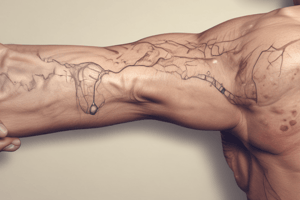Podcast
Questions and Answers
Which of the following factors do not affect the appearance of a scar?
Which of the following factors do not affect the appearance of a scar?
- Location on the body
- Blood type (correct)
- Age
- Skin type
What is the importance of wound-edge eversion in obtaining a fine linear scar?
What is the importance of wound-edge eversion in obtaining a fine linear scar?
- It provides strength to the closure
- It relieves tension on the wound edges (correct)
- It prevents infection
- It helps with wound healing
Which of the following is not a surgical option for scar management?
Which of the following is not a surgical option for scar management?
- Silicone gel (correct)
- Simple scar revision
- W-plasty
- Z-plasty
Which of the following is NOT an individual factor that affects scar appearance?
Which of the following is NOT an individual factor that affects scar appearance?
What is the effect of skin that is oily or pigmented on scar appearance?
What is the effect of skin that is oily or pigmented on scar appearance?
Which of the following is NOT a surgical technique that can help obtain a fine linear scar?
Which of the following is NOT a surgical technique that can help obtain a fine linear scar?
Flashcards are hidden until you start studying
Study Notes
Obtaining a Fine-Line Scar: Factors Affecting Scar Appearance and Surgical Techniques
- Scars are inevitable when there is a full-thickness injury to the skin or an incision is made.
- The final appearance of a scar depends on individual factors, wound factors, systemic conditions, and surgical technique.
- Individual factors affecting scar appearance include age, skin type, location on the body, direction and shape of the wound.
- Older individuals tend to have less obvious and less prone to stretching scars due to changes in skin elasticity and subcutaneous tissue.
- Skin that is oily or pigmented tends to produce more unsightly scars.
- Certain anatomic areas such as the shoulder and sternal area tend to produce unfavorable scars while eyelid scars usually heal with a fine-line scar.
- The direction of the wound is important as scars that cross relaxed skin tension lines (RSTL) at right angles tend to be more noticeable.
- Systemic conditions such as nutritional status, congenital disorders, vascular disease, and anemia can affect wound healing and scar appearance.
- Surgical techniques such as careful handling of tissue, wound-edge eversion, and prompt removal of skin sutures can help obtain a fine linear scar.
- Wounds should be closed without tension using sutures, staples, skin tapes, or wound adhesives to ensure primary healing with minimal scarring.
- Dermal sutures provide strength to the closure and relieve tension on the wound edges, while slight wound eversion is essential for better aesthetic results.
- Scar management options include medical treatments such as silicone gel and sheets, steroids, pressure, and laser therapy, as well as surgical options such as simple scar revision, Z-plasty, and W-plasty.
Obtaining a Fine-Line Scar: Factors Affecting Scar Appearance and Surgical Techniques
- Scars are inevitable when there is a full-thickness injury to the skin or an incision is made.
- The final appearance of a scar depends on individual factors, wound factors, systemic conditions, and surgical technique.
- Individual factors affecting scar appearance include age, skin type, location on the body, direction and shape of the wound.
- Older individuals tend to have less obvious and less prone to stretching scars due to changes in skin elasticity and subcutaneous tissue.
- Skin that is oily or pigmented tends to produce more unsightly scars.
- Certain anatomic areas such as the shoulder and sternal area tend to produce unfavorable scars while eyelid scars usually heal with a fine-line scar.
- The direction of the wound is important as scars that cross relaxed skin tension lines (RSTL) at right angles tend to be more noticeable.
- Systemic conditions such as nutritional status, congenital disorders, vascular disease, and anemia can affect wound healing and scar appearance.
- Surgical techniques such as careful handling of tissue, wound-edge eversion, and prompt removal of skin sutures can help obtain a fine linear scar.
- Wounds should be closed without tension using sutures, staples, skin tapes, or wound adhesives to ensure primary healing with minimal scarring.
- Dermal sutures provide strength to the closure and relieve tension on the wound edges, while slight wound eversion is essential for better aesthetic results.
- Scar management options include medical treatments such as silicone gel and sheets, steroids, pressure, and laser therapy, as well as surgical options such as simple scar revision, Z-plasty, and W-plasty.
Studying That Suits You
Use AI to generate personalized quizzes and flashcards to suit your learning preferences.




